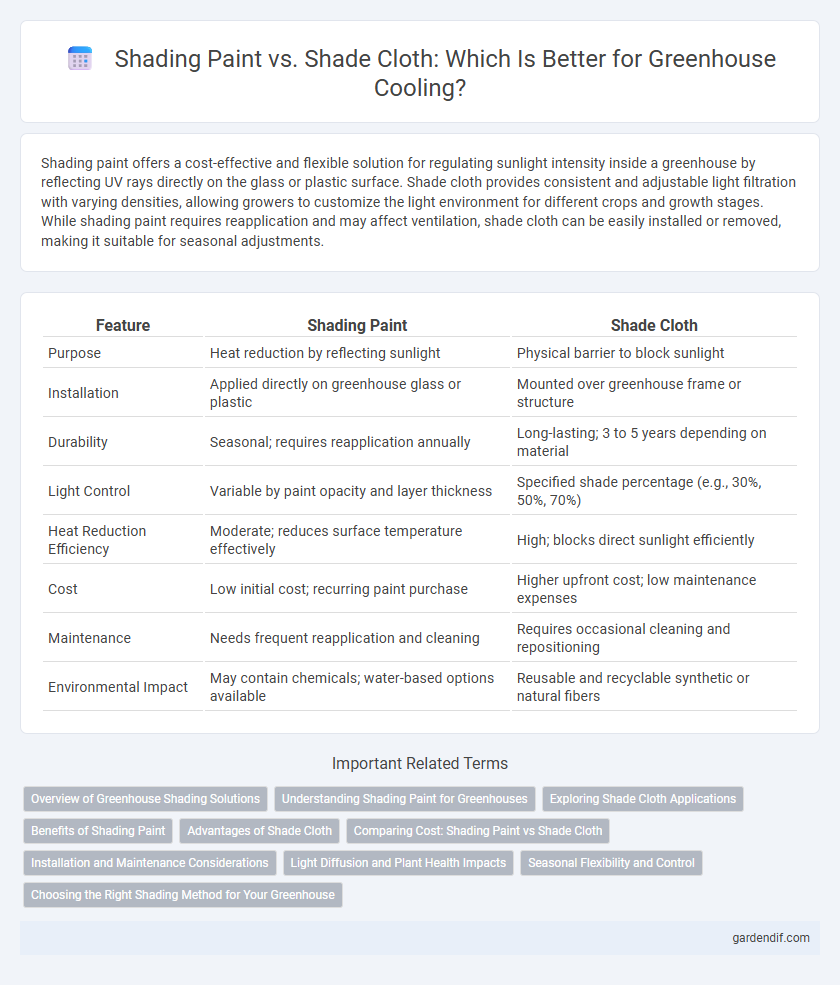
Shading Paint vs Shade Cloth Illustration
Shading paint offers a cost-effective and flexible solution for regulating sunlight intensity inside a greenhouse by reflecting UV rays directly on the glass or plastic surface. Shade cloth provides consistent and adjustable light filtration with varying densities, allowing growers to customize the light environment for different crops and growth stages. While shading paint requires reapplication and may affect ventilation, shade cloth can be easily installed or removed, making it suitable for seasonal adjustments.
Table of Comparison
| Feature | Shading Paint | Shade Cloth |
|---|---|---|
| Purpose | Heat reduction by reflecting sunlight | Physical barrier to block sunlight |
| Installation | Applied directly on greenhouse glass or plastic | Mounted over greenhouse frame or structure |
| Durability | Seasonal; requires reapplication annually | Long-lasting; 3 to 5 years depending on material |
| Light Control | Variable by paint opacity and layer thickness | Specified shade percentage (e.g., 30%, 50%, 70%) |
| Heat Reduction Efficiency | Moderate; reduces surface temperature effectively | High; blocks direct sunlight efficiently |
| Cost | Low initial cost; recurring paint purchase | Higher upfront cost; low maintenance expenses |
| Maintenance | Needs frequent reapplication and cleaning | Requires occasional cleaning and repositioning |
| Environmental Impact | May contain chemicals; water-based options available | Reusable and recyclable synthetic or natural fibers |
Overview of Greenhouse Shading Solutions
Greenhouse shading solutions include shading paint and shade cloth, both designed to control solar radiation and temperature inside the structure. Shading paint provides a uniform film that reduces light intensity by reflecting sunlight, offering a cost-effective and low-maintenance option ideal for large surface areas. Shade cloths come in various densities and materials, allowing adjustable light filtration and ventilation, making them suitable for diverse crops and dynamic environmental conditions.
Understanding Shading Paint for Greenhouses
Shading paint for greenhouses offers a cost-effective method to control light intensity by reflecting sunlight and reducing heat buildup, enhancing plant growth conditions. Unlike shade cloth, shading paint can be precisely applied to glass or plastic surfaces, providing uniform coverage and adjustable shading levels through different dilution ratios. Understanding the thermal and light diffusion properties of shading paint helps optimize microclimate control while maintaining adequate photosynthesis for diverse crop types.
Exploring Shade Cloth Applications
Shade cloth offers versatile applications in greenhouses by effectively regulating sunlight, reducing heat buildup, and protecting plants from UV radiation. It is available in various densities, allowing precise control over light intensity, which promotes optimal photosynthesis and enhances crop quality. Unlike shading paint, shade cloth enables adjustable coverage, making it ideal for seasonal and crop-specific shading needs.
Benefits of Shading Paint
Shading paint enhances greenhouse energy efficiency by reflecting sunlight and reducing internal temperatures without restricting airflow, unlike shade cloth which can block ventilation. It offers customizable light diffusion, promoting optimal photosynthesis and improved plant growth. The paint's durability and cost-effectiveness make it a sustainable solution for long-term climate control in greenhouse environments.
Advantages of Shade Cloth
Shade cloth offers superior breathability compared to shading paint, allowing better air circulation that reduces heat buildup inside greenhouses. It provides adjustable coverage, making it easier to control light intensity and protect plants from excessive sun exposure. Durable and reusable, shade cloth withstands weather conditions and can be repositioned or removed seasonally, unlike permanent shading paints.
Comparing Cost: Shading Paint vs Shade Cloth
Shading paint generally offers a lower upfront cost compared to shade cloth, making it an economical choice for large-scale greenhouse applications. Shade cloth requires a higher initial investment due to material and installation expenses but provides durability and adjustable light control over time. Evaluating overall cost-effectiveness depends on factors like greenhouse size, climate conditions, and long-term maintenance requirements.
Installation and Maintenance Considerations
Shading paint requires thorough surface preparation and annual reapplication to maintain effectiveness, while shade cloth is installed with simple mounting hardware and offers immediate protection without frequent upkeep. Shade cloths can be easily removed or replaced depending on seasonal needs, whereas shading paint involves time-consuming removal if replacement is desired. Maintenance costs for shading paint are higher due to labor and material expenses, whereas shade cloth maintenance is minimal, focused mainly on occasional cleaning and inspection for damage.
Light Diffusion and Plant Health Impacts
Shading paint provides uniform light diffusion by creating a consistent film that reduces sunlight intensity, promoting even photosynthesis and minimizing heat stress on plants. Shade cloth offers variable light filtration based on weave density, allowing airflow while blocking harsh rays, which can prevent overheating but may create uneven shading patterns. Both methods impact plant health by controlling light exposure, but shading paint ensures more stable microclimate conditions, enhancing growth and reducing risk of leaf burn.
Seasonal Flexibility and Control
Shading paint offers seasonal flexibility by allowing precise control over solar radiation through adjustable opacity, making it easy to modify shading levels as sunlight intensity changes. Shade cloth provides consistent shading but lacks the ability to fine-tune light transmission dynamically, limiting its adaptability to seasonal variations. Greenhouse operators often prefer shading paint for its customizable control over microclimate conditions, enhancing crop growth throughout varying seasons.
Choosing the Right Shading Method for Your Greenhouse
Shading paint offers a cost-effective and uniform way to reduce sunlight intensity by reflecting solar radiation directly on the greenhouse glass or plastic. Shade cloth provides adjustable, reusable protection with varying densities to control light levels and improve ventilation, making it ideal for seasonal changes. Selecting the right method depends on your climate, crop sensitivity to light, and budget constraints to optimize plant growth and energy efficiency.
Shading Paint vs Shade Cloth Infographic

 gardendif.com
gardendif.com